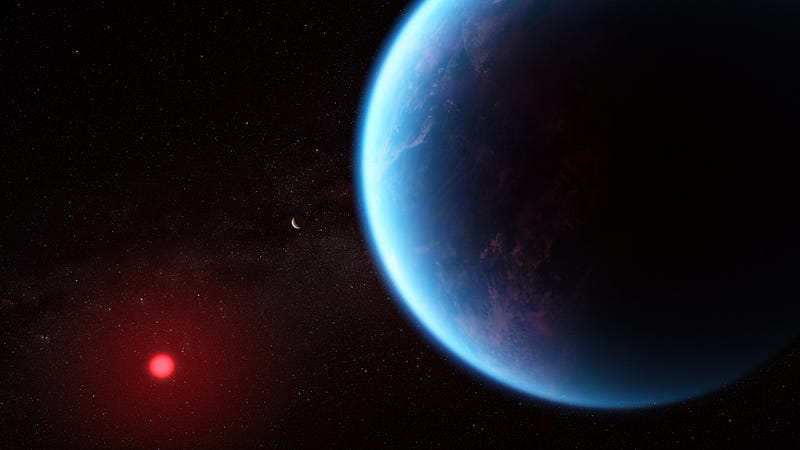Exciting Discoveries of K2-18b: A New Frontier in Astrobiology
Written on
Chapter 1: Introduction to K2-18b
Recently, NASA made headlines with an intriguing announcement: the James Webb Space Telescope (JWST) may have detected potential signs of life on the exoplanet K2-18b, located 124 light years from Earth.
This planet is theorized to be a Hycean world, which means it might possess a global ocean of water beneath a thick hydrogen-rich atmosphere. The JWST has observed significant amounts of methane and carbon dioxide, while ammonia appears to be absent, lending credibility to the hypothesis.
One particularly fascinating finding is a potential detection of dimethyl sulfide (DMS), a molecule primarily produced by Earth's oceanic phytoplankton.
This discovery raises hopes—if DMS is confirmed, it could suggest that K2-18b harbors life. However, further observations of the atmosphere are needed to ascertain the presence of DMS, and we will have to wait a few months for those results.

Chapter 2: The Environment of K2-18b
Despite the promising signs, it’s important to be cautious regarding K2-18b’s habitability.
K2-18b was discovered in 2015 within the constellation Leo, orbiting a red dwarf star. Two years later, a neighboring exoplanet, K2-18c, was identified, which orbits its star at a distance of just 0.06 AU and completes a revolution in only nine Earth days. In contrast, K2-18b orbits at a distance of 0.14 AU and takes 33 days to complete one orbit.
The planet's radius is 2.37 times that of Earth, but its mass is nearly nine times greater. This unique combination places its density somewhere between Earth and Neptune, leaving its classification uncertain. It could either be a rocky planet with a dense atmosphere or more Neptune-like, potentially rich in ices.
Although researchers have speculated about K2-18b being a Hycean planet, the lack of definitive evidence means we should remain skeptical. In 2019, the Hubble Space Telescope detected water vapor in its atmosphere, prompting further investigation by the JWST.
The public has eagerly embraced the idea that K2-18b may be inhabited or at least capable of supporting life. However, various studies present conflicting interpretations. Some suggest that while it could be a Hycean world with microbial life, it may just as easily be an uninhabited gas-rich planet.
Currently, K2-18b has a cool temperature of around -8°C, which could be explained by its gas-rich composition. A Hycean world would typically experience a runaway greenhouse effect, leading to significantly higher temperatures.
In this video titled "James Webb Telescope Discovers Signs of Life on K2-18b, 120 Lightyears Away... but there's a problem," experts discuss the implications of JWST's findings and the challenges of verifying them.
Chapter 3: The Challenges of Habitability
Further complicating the matter, another study suggests that K2-18b may have a magma ocean, making it inhospitable for life as we know it.
So, what exactly is K2-18b? Is it a Hycean planet teeming with life or merely a typical mini-Neptune with a gas-heavy atmosphere?
Even if K2-18b were to be classified as a Hycean world, several factors would still hinder its potential for supporting life. Firstly, Hycean planets remain largely theoretical, and while it is possible to speculate about their existence, conclusive evidence is still lacking.
An ocean-covered world wrapped in a thick atmosphere may seem ideal, but the extensive water vapor could act as a greenhouse gas, potentially leading to the loss of its oceans due to boiling.
If we assume that K2-18b can maintain its oceans, they would likely be extremely deep, resulting in high pressure. The estimated surface gravity of 1.27g would further complicate any possibility of life.
Additionally, K2-18b is thought to be tidally locked, meaning one hemisphere is continuously exposed to its star's radiation while the other remains in perpetual darkness.
In summary, there are numerous reasons to believe that K2-18b may be too extreme to support life, or perhaps too hostile to even have a significant surface.
This second video, "Did JWST Just Confirm Alien Life on K2-18B?" dives deeper into the ongoing debate about the planet's potential for hosting life, featuring insights from leading scientists in the field.
Thank you for reading my article! If you would like to support a young writer, please check out my Ko-fi! You can also explore my other blog focused on space topics here!